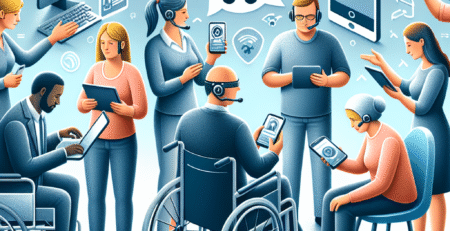Mobile Learning Trends 2025 Reshaping Corporate Training
As we look forward to 2025, it’s exciting to think about how mobile learning is reshaping corporate training. The past few years have revealed the power of mobile technologies, and it’s clear they’re becoming integral to how we build and retain talent in organizations. In my experience, understanding these trends can help us embrace innovations that elevate our learning strategies. Mobile learning is not just a passing trend; it’s a fundamental shift in how we think about employee development.
The Shift Towards Mobile Learning
Mobile learning has evolved significantly in recent years. With the rise of smartphones and tablets, we have shifted from traditional training methods to mobile-centric approaches. This change brings flexibility and accessibility to learning opportunities. Whether employees are on the go, working from home, or at their desk, mobile learning ensures that training is within reach.
Consider that, by 2025, mobile learning is expected to account for up to 70% of all e-learning activities. This statistic highlights a considerable shift in how organizations deliver training. The convenience and instant access to information are undeniable. Employees can dive into training materials when it suits them best, making the learning process far more effective.
Understanding the Benefits of Mobile Learning
The benefits of mobile learning are vast and varied. First and foremost, mobile learning fosters a culture of continuous improvement. When employees can learn anytime and anywhere, they feel encouraged to engage with training materials more frequently. This constant access leads to retention of knowledge and skills.
Additionally, mobile learning supports personalized learning experiences. Employees can choose what and how they learn based on their specific needs and career goals. This autonomy increases engagement, allowing employees to take ownership of their professional growth.
Moreover, mobile learning enhances collaboration among team members. When employees can access shared resources from their devices, they can work together more easily, irrespective of their physical location. This collaboration can lead to innovative solutions and stronger teamwork.
Key Mobile Learning Trends to Watch
As we dive into 2025, several key trends in mobile learning are poised to shape corporate training. I find it helpful to break these down into manageable insights:
Microlearning: The trend of microlearning focuses on delivering information in bite-sized chunks. Instead of lengthy training sessions, companies are now opting for short, focused lessons that can be completed in a few minutes. This approach fits seamlessly into employees’ busy schedules, allowing them to learn without feeling overwhelmed.
Gamification: Incorporating game elements into training can enhance engagement. Mobile learning platforms are increasingly featuring quizzes, leaderboards, and rewards to motivate learners. Gamification not only makes learning fun but also encourages friendly competition, driving employees to excel in their development.
Social Learning: Employees now seek social aspects in their learning experiences. By integrating forums, discussion boards, and peer-to-peer learning within mobile platforms, organizations can enable employees to share knowledge. This collaborative approach can enhance understanding and promote community learning.
AR and VR Integration: The use of augmented reality (AR) and virtual reality (VR) in mobile learning is on the rise. These technologies create immersive learning experiences, allowing employees to practice skills in safe environments. Whether simulating customer interactions or complex machinery operations, AR and VR bring training to life.
The Impact of Data Analytics on Mobile Learning
One of the most significant advantages of mobile learning is the wealth of data it generates. By collecting data on user engagement, progress, and performance, organizations can gain valuable insights into training effectiveness.
Mobile learning platforms are increasingly equipped with analytics tools that track which materials are being accessed, how long employees spend on specific content, and their overall performance. These insights can help organizations refine their training programs to better meet employees’ needs.
For instance, if data shows that a particular module has a high dropout rate, the organization can identify the reasons and make necessary adjustments. This data-driven approach ensures that training remains relevant and impactful.
The Importance of User Experience in Mobile Learning
As companies invest in mobile learning, user experience becomes critical. A seamless, intuitive interface is necessary for keeping employees engaged. Training platforms that are easy to navigate will encourage more users to participate actively.
In my view, organizations should prioritize simplicity and functionality in mobile learning design. Streamlining the user experience helps eliminate barriers and frustration. Employees are much more likely to embrace mobile learning when they feel confident in using the technology.
Furthermore, businesses should seek feedback from employees about their mobile learning experiences. Understanding their perspectives can lead to improvements and foster a sense of ownership. When employees feel valued in the process, their commitment to learning increases.
Anticipating Future Mobile Learning Innovations
As we approach 2025, it’s crucial to stay ahead of potential innovations in mobile learning. Emerging technologies will likely shape training methods in remarkable ways. For example, artificial intelligence (AI) could play a pivotal role in personalizing learning experiences. AI can analyze individual learning patterns and suggest tailored content.
Additionally, the integration of wearables in mobile learning is another exciting possibility. Imagine employees engaging with training materials directly through smartwatches or glasses. This hands-free approach could enhance learning in ways we haven’t yet imagined.
The growth of 5G technology will also impact mobile learning. With higher speeds and reduced latency, employees will have access to a wealth of real-time interactive content, making learning even more accessible.
Final Thoughts on Mobile Learning in Corporate Training
In conclusion, mobile learning is crucial in shaping the future of corporate training. By embracing the trends and innovations on the horizon, we can create dynamic learning environments that empower employees to thrive.
As organizations, the goal is to cultivate a culture of continuous learning. By leveraging mobile learning, we can provide the flexibility and accessibility employees need to succeed. The statistics and evidence speak for themselves: mobile learning leads to more engaged, knowledgeable, and skilled employees.
I encourage all of you to consider how mobile learning can enhance your training initiatives. Let’s embrace this shift and work together to create a brighter future for corporate training. The potential is vast, and by integrating mobile learning into our strategies, we can elevate our organizations to new heights.












Leave a Reply